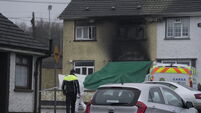Students to get bursaries to identify WW1 casualties

Of the 49,000 names listed alphabetically, enshrined on Harry Clarke decorated pages in eight volumes in the Flanders Fields Museum in Ypres, less than a quarter have been identified.
Now, a hundred years after most of them died, the government, the Belgian museum and Google have finally come up with a way to find the rest.
They are offering five students short-term bursaries over the next four years to sort through the clues and try to finally list all those who gave their lives in the war they thought would be “the war to end all wars”.
They enlisted in their thousands, many already serving-members of the world’s largest professional army at the time. But after the killing of the leaders of 1916, the mood changed and their numbers trailed off.
However, the Irish regiments remained in name, their ranks filled with British and men from the Empire’s colonies. And when they died, their names were added to the list of the Irish dead.
The black leather-bound books, printed around 1923, in their beautiful timber book case look more than a little of our place in the Flanders Fields museum that is full of interactive exhibits, photographs, recreated trenches, munitions and videos of actors with first hand accounts of the lives of soldiers and civilians.
The details in the books are scant - often only a name, maybe a place of birth, which regiment they served in and usually the date and place where they died.
Unlike many of the other 50 nations whose people died in the war, Ireland turned her back on it, having vilified the soldiers who fought in it . Only earlier this year, with the centenary commemorations looming, the Taoiseach and British Prime Minister jointly acknowledged their nation’s shared past touring Flanders graves together.
For 90 years however the Roll of Honour - the book of Ireland’s dead - was ignored with no work done to fill out the missing details. It’s hoped that Irish university history students will help reverse that, correcting and adding to the material from the vast amounts stored in the museum.
It is hoped that the public will also help as Google has digitised the book, allowing it to be searched on-line while the In Flanders Fields Museum, where the books are held - has joined the Google Cultural Institute and posted an online exhibition about the Irish World War One commemoration.
Anybody finding a relative or person they have some knowledge about in the Irish books on-line can send in documents, pictures, letters and any other relevant information to namenlijst@ieper.be. When verified it will be added to the site.
Google’s Bill Echikson says this should help increase interest in these forgotten soldiers and hopefully fill in missing details. “Everywhere that we have helped put museums on the web, interest has increased. Visitors to Pompeii increased by 25% after our Street Views, we digitised 200,000 very old books in Ghent that nobody was able to view, and now they have had 100,000 views and lots more visitors”, he said.
The book was put together by William Hickey who later became a Senator in the Irish Free State and who served with and was at the burial of the much revered John Redmond who died outside Ypres in 1916.
Just 100 copies were printed including the one brought by Hickey to Belgium and now in the Ypres museum.
Belgium commemorated the centenary of the Battle of Ypres yesterday which was attended by Ireland’s Culture Minister Heather Humphries as well as by the leaders of several of the European countries involved in the war.











